LA Orthopedic Emergencies
Limb fractures
This chapter is focused on horses as they are the most difficult to manage. Please see the food animal orthopedic unit for more information about cattle (links below). In general, small ruminants/camelids can be treated like dogs. Pigs are like dogs or humans, depending on size.
Limb fractures often lead to non-weight bearing lameness. Limb fractures are considered an emergency and should be evaluated as soon as possible.
Emergency management
While waiting for you
Some things that the owner can do while you are on your way include:
- Keep the animal calm (offering hay, treats, a buddy, etc.)
- Reduce movement of the animal as much as possible
- Hook up the trailer to prepare for a potential referral
- Apply compression if there is hemorrhage and if it is safe
Supplies needed
- Sedatives, analgesics, and tranquilizers
- Bandage and splinting supplies (cast material, PVC pipe, duct tape, etc)
- NSAIDs
- Laceration repair supplies
- Radiograph and ultrasound equipment
- IV catheter supplies
- Euthanasia solution
When you arrive at the farm
Evaluate for shock or distress. Check heart rate, respiratory rate, mucous membranes and pulse quality to ensure the animal is systemically stable. If the animal is showing systemic signs, it may have internal injuries, as well. Prognosis is generally poor in these cases.
Most horses and many other animals will likely need to be sedated before starting manipulation or assessment of the traumatized limb. The sedation will also assist with analgesia, depending on the drugs used.
Kaltura version w/ captions: Horse with a fractured forelimb, broken leg
| Potentially Useful Drugs for a Fracture Emergency | |
| Xylazine | Sedation + Analgesia |
| Detomidine | Sedation + Analgesia |
| Acepromazine | Tranquilization |
| Butorphanol | Analgesia |
| Phenylbutazone | Analgesia |
| Flunixin meglumine | Analgesia |
| Morphine (epidural) | Analgesia |
| Lidocaine (CRI) | Analgesia |
| Ketamine (CRI) | Analgesia |
**The goal of sedation is to enable you to complete an exam, manipulation, and stabilization of the affected limb without causing ataxia and increased risk of further injury. Physical restraint, such as a twitch or stocks, can also be useful, depending on the case.
Continued assessment
Determine where the fracture is likely located and if there is any instability or laxity within the limb. Radiographs are useful for distal limb injuries; ultrasound may be needed for proximal injuries. If there is a wound over the fracture location, it is considered an open fracture until proven otherwise and should be treated as such.
General fracture stabilization
Rapid limb stabilization is very important so the animal does not cause further injury to itself. Stabilization can help protect neuromuscular structures, prevent a closed fracture from becoming open, protect an open fracture from continued contamination, prevent further luxation, and prevent additional damage to the bones, cartilage, and surrounding tissues that will be needed for healing.
The goal of splinting is to prevent movement of the fracture in the medial-lateral direction and in the dorso-palmar or dorso-plantar direction. Splints should be placed perpendicularly to each other (eg one lateral and one dorsal). The proximal limb will act like a pile driver and distract lower limb fractures. This is minimized by supporting the limb with the dorsal cortices aligned.
Splints: get creative! Broom or pitchfork handles, PVC pipes, metal pipes, pieces of wood, etc. are all reasonable options as long as they are safe and sturdy. There are also manufactured splints for horses, such as the Kimzey splint, that are easy to use. You can also create your own splint by applying cast material over a light bandage (cast bandage).
Kaltura version w/ captions: How to place a Kimzey Leg Saver Splint on a front limb
In most cases, you are creating a modified Robert-Jones bandage that stabilizes the limb from foot to the joint above the fracture. Padding is useful to protect the limb but only if it is well compressed as applied. Loose padding will settle and change shape. Place a layer of padding and secure snugly with brown gauze. Apply splints or cast material. Cast material should extend down past the coronary band but does not need to cover the foot. It will be removed at the referral site so is functioning as a temporary support. Splints should be placed on two adjacent aspects of the limb and secured with duct tape or white tape. Splints should reach the ground.
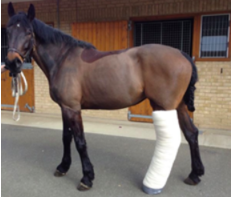
Cast material is easy to carry in the truck and a bandage cast may be easier than splinting.
Forelimb fracture stabilization
Distal limb (below mid-metacarpus)
The bandage and splint must extend from the ground to the carpus. To prevent damage from the upper limb, the dorsal cortices need to be aligned (toe pointed downward). Apply the splints dorsally and laterally or apply a Kimzey splint in the same fashion (with the toe pointed)
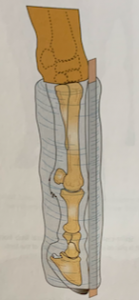
Fracture between distal metacarpus and proximal carpus
Robert-Jones bandage or bandage cast with lateral and palmar splints extending from the ground and up the limb past the elbow should be applied . The foot is flat (not toe pointed)
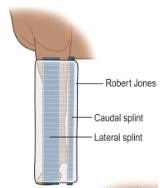
Radial fracture
Place a Robert-Jones or cast bandage from the ground to the elbow. Include a palmar splint extending from the ground to the elbow and a lateral splint extending from the ground to the withers.
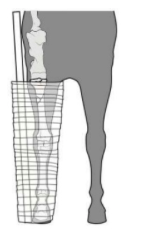
Olecranon fracture
A horse with an olecranon fracture will have a dropped elbow with a flexed carpus; it will look like radial nerve paralysis. The ulna is not weight bearing so stabilization is designed to lock the carpus in extension. This lets the horse bear weight on the limb and minimizes the risk of laminitis. Use a light bandage (not a Robert Jones) that extends as high as possible past the elbow, with a palmar splint.

Humeral fracture
Any humeral fractures will be stabilized by muscles of the limb. Do not attempt to splint the fracture as this will only distract the fracture further. If needed, use a light splint to lock the carpus in extension
Hindlimb fracture stabilization
Distal limb (below mid-metatarsus)
The bandage and splint must extend from the ground to the tarsus. To prevent damage from the upper limb, the dorsal cortices need to be aligned (toe pointed downward). Apply the splints dorsally and laterally or apply a Kimzey splint in the same fashion (with the toe pointed)
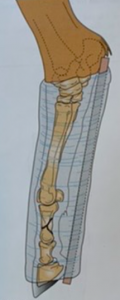
Metatarsal fracture
Allow the animal to stand normally and do not point the toe. Apply a Robert-Jones bandage or cast bandage with lateral splint extending past the tarsus and plantar splint to the calcaneus
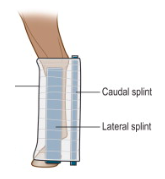
Hock or tibial fractures
These are rare fractures and hard to stabilize. Apply a Robert-Jones bandage or cast bandage from the ground to the stifle with a lateral splint extended at least to the hip. In a foal, consider a Thomas-Schroeder splint.
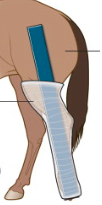
Femur fracture
Stabilization is by the muscles of the limb. Do not splint; this only creates a fulcrum and does not help with fracture stabilization.
Referral
In general, long bone fractures in adult horses and cattle have a poor prognosis. Our implants are not designed for the amount of forces placed on a limb by large animals. Foals and adult llamas have a guarded prognosis due to their larger size and current/future activity levels. Calves, small ruminants and alpacas tend to do fine as long as the fracture has good blood supply and is stabilized. Motion will prevent healing and healing cannot occur without blood supply.
Open fractures, articular fractures, and comminution will lower the prognosis. Open fractures mean infection. Fracture repair in larger animals is a race between healing and implant breakage. Since infection will slow healing, implant breakage tends to win over healing in open fractures. Articular fractures lead to arthritis and early retirement or limited performance. In most cases, a long bone fracture must have a strut (vertical piece of bone) for repair to be successful; comminution can make that tricky. Non-weight bearing bones (splint bones, ulnas) are an exception; with enough resources, these are typically fixable, even in larger animals. If you are unsure, call the referral center for advice.
Physeal fractures can alter growth (depends on the age of the animal) and some are articular. See physeal disorders chapter
Once the fracture is stabilized, radiographs can be taken and/or the animal trailered to a referral hospital. When trailering horses, think about the stabilization needed during braking and accelerating. If the horse has a fractured forelimb, face them backwards in the trailer. If the horse has a fractured hindlimb, face them forwards in the trailer. Allow the horse to have the use of its head to balance in the trailer, but do not allow them to turn around.
Prognosis
| Treatment and Prognosis for Return to Former Use | |||
| Fracture Location | Fracture Type | Treatment | Prognosis |
| Distal phalanx | articular | medical or surgical | guarded |
| Distal phalanx | non-articular | medical | good to very good |
| Middle phalanx | comminuted | medical or surgical | guarded |
| Proximal phalanx | comminuted | surgical | guarded to poor |
| Proximal phalanx | non-comminuted | medical or surgical | good |
| Metacarpal III or metatarsal III | various | surgical | poor to good (depends on fracture type) |
| Olecranon | various | surgical | guarded to good (depends on fracture type and age of horse) |
| Radius | open | surgical | poor |
| Radius | closed | surgical | fair to good for lighter horses, poor for heavier horses |
| Tibia | physeal | surgical | good |
| Tibia | diaphyseal | surgical | guarded to poor |
| Humerus | complete | medical | poor |
| Femur | physeal | medical or surgical | guarded to poor |
| Femur | diaphyseal | surgical | guarded to poor |
Incomplete, stress fractures and cuboidal bone fractures
Racehorses can get stress fractures and incomplete fractures. These do not need stabilization but the horse needs to be kept calm and may need to be kept in a standing position. Getting up and down can cause these fractures to become complete. Cuboidal bone fractures may need to be repaired (lag screw fixation) or fragments removed arthroscopically, depending on size of the fragment.
Key Takeaways
Limb fractures need to be stabilized for transport. Assume you need two splints set perpendicularly or a bandage cast. Call for advice about prognosis (is it worth referring) and stabilization.
Calf bones want to heal but motion will prevent that. Stabilization is needed and you cannot get good stability with a splint.
Resources
Fracture Stabilization and Management in the Field. 2021 VCNA Equine- great pics and hints
Ultrasonographic diagnosis of femoral fractures in large animals. 2022 JAVMA 260(13), 1675-1682- file download
A review of equine tibial fractures. 2022 EVJ.
Equine Emergencies: Treatment and Procedures. Orsini, J. A., & Divers, T. J. (2014).St. Louis, MO: Elsevier/Saunders.

